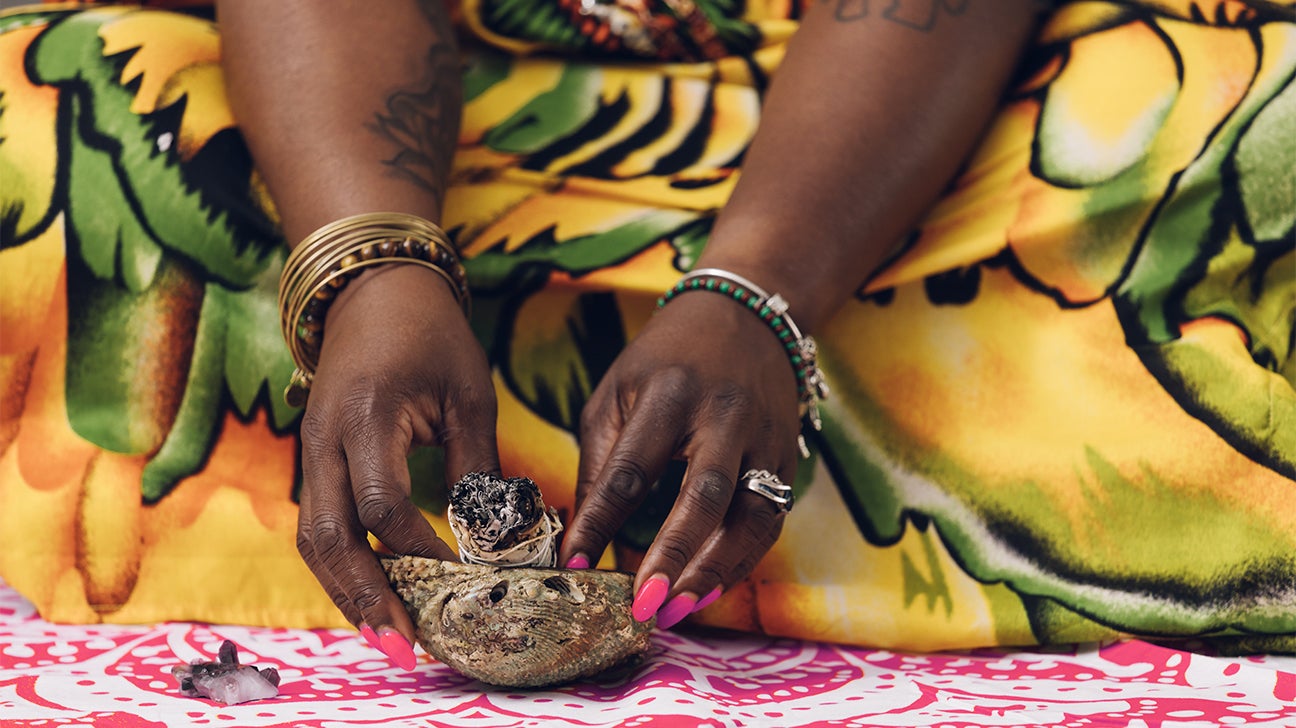
A practice old as time, developed by indigenous peoples, burning sage — also known as “smudging” — has traditionally been used to help clear negative energy.
However, fast forward thousands of years, and high-wire anxiety is not only common but expected. The 21st century seems to pump out negative energy (looking at you, 2020, you turd). But is sage smudging an effective counter to modern pressures?
Well, it’s one of many methods some practitioners continue to recommend for relaxation, focus, and combating everyday stress. Those who engage in these cleansing rituals claim that burning dry sage can help clear the air and promote mindfulness.
So does it work? And, if so, how? Are the ethical concerns around sage burning worth it? We inhaled deep and decided to impart some sage wisdom…
So, what is sage?
Sage is an aromatic plant that’s long played roles in the worlds of both medicine and food. Americans probably recognize the herb for its use in stuffing around the holidays, but this leaf does more than jazz up what you shove inside your turkey.
Ancient Romans called sage a salvation plant (literally, salvare, meaning “save” or “cure”), and sage has been used in ancient Egyptian, Roman, and Greek medicines for its natural healing properties. It is a triple-OG of herbal medicine.
While sage has deep historical roots, that doesn’t mean it isn’t relevant in modern medicine.
According to recent studies, sage has powerful antioxidant and anti-inflammatory qualities. It’s been studied (with mixed results) for a whole host of issues, including:
- depression
- dementia
- obesity
- lupus
- heart disease
- cancer
Dried sage, especially white sage, was traditionally used by Native Americans, specifically as a method of purification. This is the term that most often springs to mind when we hear the word “smudging.”
Smudging, however, is an English term used to describe the process. Most Native American groups have their own unique words to explain the practice.
“Smudging is the process of burning dried plants or other natural elements and then using the smoke to cleanse themselves, objects, or even places,” explains Rosalyn LaPier, Ph.D., an award-winning Indigenous writer and ethnobotanist.
“Usually the dried plants are burned over a hot coal placed in a large shell or on the ground. The person places both hands over the smoke, takes the smoke within her hands, and beginning with her head and continuing downward, ‘washes’ her entire body with the smoke.”
This ancient Native American practice remains in popular use today. As it gains more popularity in mainstream culture, however, it’s important to honor and respect the cultural roots of smudging before giving it a go and weigh the potential ethical concerns with the perceived health benefits.
The potential benefits of burning sage
There isn’t a lot of research on burning sage, but on an anecdotal level, plenty of people say they experience benefits from doing so.
1. Air purification
Sage could be a natural air purifier. One older study revealed that the use of medicinal smokes such as sage resulted in a 94% reduction in airborne bacteria.
2. Mindfulness
Burning sage can help you in the pursuit of mindfulness.
“In theory, if you bring more awareness to what you are doing, especially by engaging your senses, you can reduce your stress — so something like smudging really does that,” says Christopher Willard, PsyD, author of Raising Resilience.
“It’s close to mindfulness, in which we bring our full sensory attention to what we are doing, and that’s easier to do with a sweet-smelling movement practice, like smudging.”
Mindful meditation can actually change your brain and help you handle stress, so if burning sage helps you relax and enter a more focused brain space, then it’s totally worth it.
3. Aromatherapy
Sometimes an aroma alone can chill you out, regardless of its underlying chemical properties.
Gina Smith Pasqualini, certified aromatherapist and founder of Good Living is Glam, says that even if you’re skeptical about the science behind burning sage, there can still be benefits to participating in the practice.
“Whether or not you believe that energy can be cleared by smudging, the scent alone can have a grounding effect. This allows you to think more clearly, reduces anxiety, and creates a sense of calm in your day-to-day life,” Pasqualini says.
If the scent of sage isn’t your thing, you can also incorporate other aromatics into your smudge stick as well. Lavender, rosemary, cedar, rose, thyme, and yerba santa are all great additions to burning sage.
Several of these aromatics aren’t just pleasant to smell, but are also known for their therapeutic properties. Research shows that lavender, for example, can significantly reduce stress levels.
4. Belief in intention
We all probably identify with the desire to engage in a peaceful ritual in a space of our very own. And this, Pasqualini says, can help provide a “grounding effect” that allows us to relax and focus our thoughts.
Willard agrees. “Rituals and routines can help calm us by bringing order and predictability to life,” he says. “So whether you believe sage itself has mystical qualities or not, the ritual will almost certainly reduce tension.”
Whether you’re smudging for spiritual reasons or simply to relax, engaging in this mindful practice can calm and center.
However, rituals and mantras needn’t revolve around ethically questionable cultural practices. You can build yourself a personal mantra that helps center you and get you through every day.
Buying sage ethically and respectfully
Sage burning is more controversial than it would first appear.
Before you dive into burning sage in your living room, it’s important to make sure you understand where the ritual comes from. As smudging has become more popular, it’s introduced a commercial element to an ancient practice. This calls into questions of ethics and cultural appropriation.
In short, if you’re going to monetize cultural heritage, make sure the money goes to its originators and their communities.
There is a dark side to sage burning: While you can go to a trendy herbalist and buy a sage wand in the 21st century, indigenous people underwent serious persecution for burning sage on the grounds of “witchcraft.” Plus, white sage is at risk of being endangered and is often illegally harvested.
Be sure to buy high-quality and ethically, legally sourced sage, which means you’ll probably want to avoid mass-market retailers. It’s great to buy local, from a Native American-owned business, if possible.
Also remember to be respectful of the practice. Cultural appropriation is never cool, and as the practice of burning sage becomes more mainstream, it’s important to remember that we should respect and engage in the practice without co-opting it thoughtlessly.
Pasqualini was introduced to smudging by her mother, who was born and raised in the Dominican Republic, where burning herbs was common for clearing energy. She emphasizes that, while it’s important to respect the cultural significance of smudging, everyone can benefit from the practice.
“There are different forms of dance or music that originated elsewhere,” Pasqualini explains. “We use those creative and sometimes spiritual arts to unite people from different cultures. Smudging is no different, and should be used to improve our collective health.”
Consider the purpose of your smudging too. If you’re simply looking to relax or soothe a headache, there are essential oils you can try.
How to burn sage
If you’re interested in trying smudging, Pasqualini recommends getting used to the smell of sage first — it’s not like the sage you put in stuffing.
“Sometimes people think it will smell like the sage you cook with. However, California white sage — which is commonly used in smudge sticks — has an herbaceous, woodsy, and slightly astringent scent,” she says.
“I recommend using a smudge stick that’s approximately 3-5 inches long for a small space or to keep handy in your personal ritual kit. The smaller size also helps avoid being overcome by too much smoke as you learn how to use it.”
Ready to engage in the practice? It’s not too far away from the practice of burning incense. So if you’re used to pretty smells wafting through your living space, you’ll have a good head start. Here’s how to get started:
- Make sure to use a heat-proof bowl or abalone shells to hold your smudge stick.
- Once you’re ready to engage, light the end of the sage bundle until it starts to smoke.
- Be sure to light the sage evenly, and — after letting it burn for a few seconds — the flame should go out on its own. (If it doesn’t, blow it out gently.)
- Pasqualini recommends repeating your intention throughout the ritual, almost like a smudging prayer.
- Then, you can carry your smoking sage throughout your house to clear your space — using the bowl to catch any ashes, of course — or carefully move it at a safe distance around your body. Be sure to crack any windows or doors and visualize getting rid of any negative energy to help focus your thoughts.
“The ingredients can be wrapped inside of the sage bundle, or bundled separately, in the case of cedar and rosemary,” Pasqualini says. “Or you can burn loose, dried ingredients in an abalone shell as an alternative to a wrapped bundle.”
And, as with any fire or smoke-related practice, be sure you don’t leave a burning sage smudge stick unattended. It’s always better to be safe than sorry. If your bedroom is on fire, it kind of undoes the relaxing effects of a smudge stick.
If you’d rather avoid open flames while trying to relax, essential oils may be of service.
Make your own smudge stick
If you’re struggling to find a local, Native American-owned businesses to purchase from — but feel like you’d really benefit — you can try putting your own together.
1. Gather supplies
You’ll need white sage, string, scissors, and any additional aromatics (like dried lavender, cedar, or rose).
2. Arrange your bundle
Layer your herbs, starting with the largest as a base, and arrange them however you like. There’s no right or wrong way!
3. Wrap it with cotton twine or string
Starting in the center, wrap the string toward the top of the bundle before returning to the base. Be sure to crisscross the string tightly, but not to the point where you crush the contents. Cut off any excess string.
4. Let it dry
Hang the bundle upside down in a cool, dry place for at least a week.
5. Smudge!
Light one end evenly over a heat-safe bowl or abalone shell. Let it burn for a few seconds before putting out the flame. Set an intention and carefully use the smoking sage stick to cleanse your space while practicing mindfulness.

Takeaway
The science on sage burning is thin on the ground, but its cultural history of helping people feel better and regain clarity is long-documented.
If you’re looking for ways to feel better or even just to zone out from modern life in healthful ways, it sometimes helps to look back to the way people lived before screens, factories, and smog.
You may well be planning to give sage smudging a try. If you do, always pay respect to its roots. And if it doesn’t do much for you, there are plenty other natural ways to unwind and recalibrate.

0 Commentaires